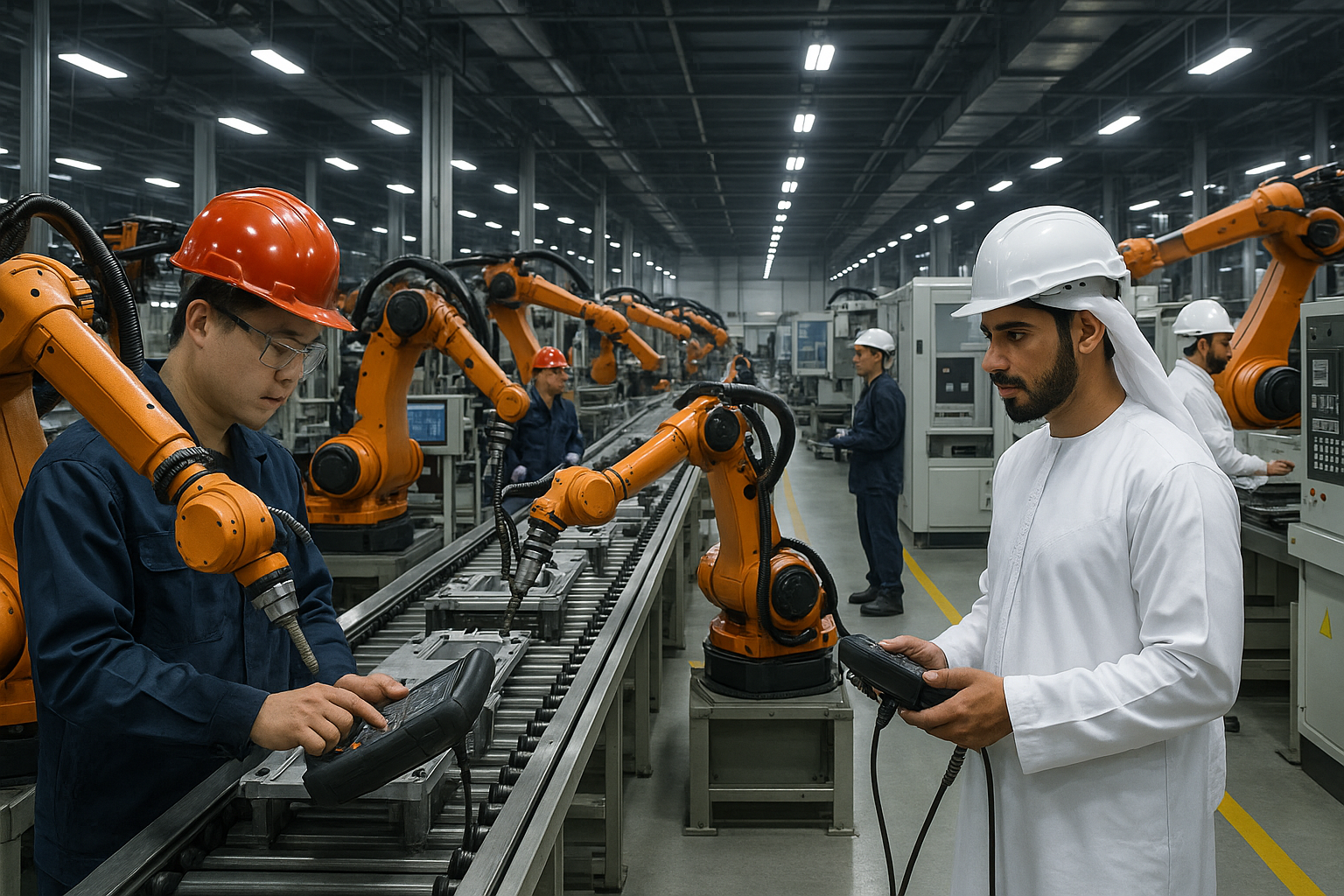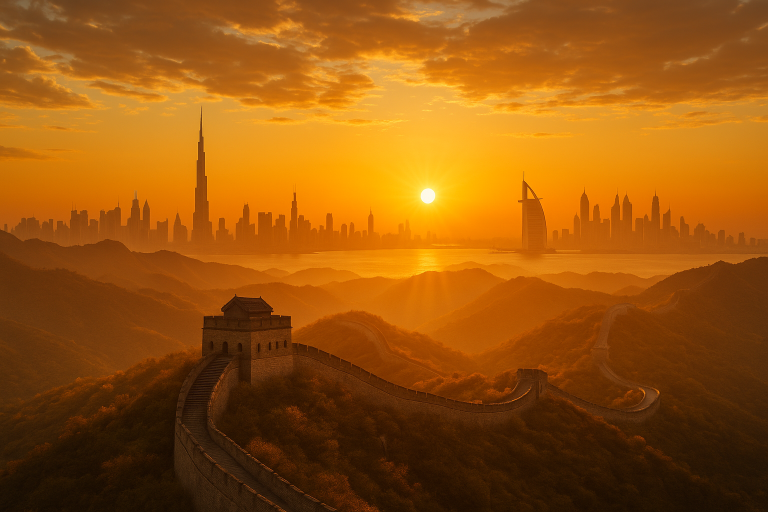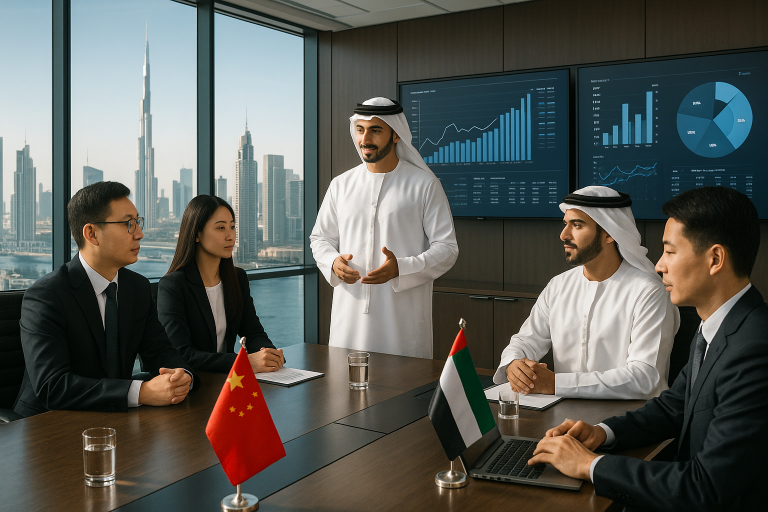Manufacturing Excellence: Building a New Industrial Powerhouse Together
Introduction
Deep within the sprawling Khalifa Industrial Zone Abu Dhabi (KIZAD), a new generation of high-tech factories are humming with activity. Inside one, advanced polymers are being synthesized for use in the aerospace and automotive industries. In another, components for massive solar power projects are being assembled, ready for deployment in the desert sun. These are not just factories; they are the tangible symbols of a new economic era for the United Arab Emirates, and they are the fruits of a deep and strategic partnership with the People’s Republic of China. The China-UAE collaboration in manufacturing is a cornerstone of the UAE’s economic diversification strategy. It is a powerful alliance that combines China’s unparalleled industrial expertise and technological prowess with the UAE’s world-class infrastructure, investment capital, and strategic location to forge a new, advanced manufacturing powerhouse in the heart of the Middle East. This article explores the key dimensions of this industrial cooperation, from the national strategic vision that drives it to the success of joint ventures in critical sectors, the vital role of purpose-built industrial zones, and the shared ambition to lead the next industrial revolution, Industry 4.0, together.
The Strategic Vision: Diversification Beyond Oil
For several decades, the UAE’s economic prosperity has been built on its vast hydrocarbon wealth. However, the nation’s visionary leadership has long recognized that long-term, sustainable prosperity requires a diversified economy. A central pillar of this diversification strategy is the development of a robust and advanced industrial sector. Ambitious national strategies, such as Abu Dhabi’s “Operation 300bn,” which aims to more than double the industrial sector’s contribution to the nation’s GDP by 2031, have laid out a clear roadmap. The goals are to enhance economic self-sufficiency, create high-skill employment opportunities for a growing population, and establish the UAE as a global hub for the industries of the future.
In pursuing this ambitious industrialization drive, the UAE has found an ideal partner in China. Often referred to as the “world’s factory,” China possesses an unrivaled depth and breadth of experience across the entire manufacturing spectrum, from heavy industry and raw material processing to the most sophisticated high-tech production. As part of its Belt and Road Initiative, China has been actively seeking to export its industrial capacity, sharing its expertise and co-investing in manufacturing projects around the globe. This has created a perfect synergy with the UAE’s strategic objectives. The UAE offers the investment capital, the world-class logistics, the stable business environment, and the strategic market access, while China provides the technology, the operational know-how, and the economies of scale. It is a partnership that is perfectly balanced for mutual success.
Joint Ventures and Technology Transfer in Action
The primary model for China-UAE industrial cooperation is the joint venture (JV). This model goes far beyond simple financial investment. It is a mechanism for deep collaboration and, most importantly, for the effective transfer of technology, operational expertise, and modern management practices. Through these JVs, the UAE is not just building factories; it is building a domestic knowledge base and cultivating a skilled workforce capable of competing at the highest international standards.
Case Study 1: Renewable Energy Manufacturing
Reflecting the two nations’ shared commitment to sustainability, one of the most significant areas of industrial cooperation is in the manufacturing of components for the renewable energy sector. Several joint ventures have been established to produce solar panels, inverters, and the structural components for solar farms. This collaboration is a powerful example of strategic alignment. It directly supports the UAE’s ambitious clean energy targets by localizing the supply chain for its massive solar power projects. It reduces reliance on imports, creates green jobs, and positions the UAE as a potential exporter of solar technology to the wider region. Chinese partners bring their mature technology and large-scale production experience, which, when combined with the UAE’s investment and local knowledge, creates a highly competitive manufacturing operation.
Case Study 2: Advanced Materials
The partnership is also making significant strides in the production of advanced materials, which are the building blocks of modern industry. Joint ventures have been established in sectors like specialty chemicals, polymers, and industrial metals. For example, a major JV in Abu Dhabi is now producing high-value petrochemical products that were previously imported. This not only enhances the UAE’s industrial self-sufficiency but also moves the country further up the value chain, from simply exporting crude oil to processing it into more valuable finished products. The advanced materials produced by these JVs are critical inputs for a wide range of other industries in the UAE, including construction, automotive, aerospace, and packaging, creating a powerful multiplier effect across the economy.
The Ecosystem: Industrial Zones and Free Zones
Modern manufacturing does not happen in a vacuum. It requires a carefully planned and highly supportive ecosystem of reliable power, water, world-class logistics, and a streamlined regulatory environment. The UAE has excelled at creating this ecosystem, and it has become a major draw for Chinese industrial investment.
The centerpiece of this effort is the China-UAE Industrial Capacity Cooperation Demonstration Zone, located within the Khalifa Industrial Zone Abu Dhabi (KIZAD). This massive, purpose-built industrial park is a flagship project of the Belt and Road Initiative and is specifically designed to attract and support Chinese manufacturers. It offers a comprehensive, “plug-and-play” solution for companies looking to set up operations. This includes pre-built warehouses and factory facilities, guaranteed access to utilities, dedicated customs and logistics services, and a range of financial and administrative incentives. Crucially, the zone’s location directly adjacent to the COSCO-operated terminal at Khalifa Port provides a seamless and highly efficient link to global supply chains, allowing manufacturers to easily import raw materials and export their finished goods to markets across the Middle East, Africa, and Europe.
Beyond this dedicated zone, other industrial areas and free zones across the UAE, such as the Jebel Ali Free Zone (JAFZA), also play a vital role. Their world-class logistics infrastructure, warehousing facilities, and business-friendly regulations provide the essential support services that manufacturers need to operate efficiently and competitively. This network of well-managed industrial ecosystems is a core component of the UAE’s value proposition and a key reason why it has become the preferred location for Chinese companies looking to establish a manufacturing presence in the region.
The Future: Industry 4.0 and Advanced Manufacturing
As the industrial partnership between China and the UAE matures, the focus is shifting from traditional manufacturing to the cutting-edge frontier of Industry 4.0. Both nations share an ambition to not just participate in the next industrial revolution, but to lead it. The vision is to move up the value chain, focusing on high-tech, knowledge-intensive manufacturing that delivers greater economic value and creates higher-skilled jobs.
The future of the collaboration lies in the creation of fully automated “smart factories.” These are facilities where production processes are optimized using robotics, artificial intelligence, and the Internet of Things (IoT). In these factories of the future, AI algorithms will manage production lines, robotic arms will handle assembly, and a network of IoT sensors will monitor every aspect of the operation in real-time, predicting maintenance needs, ensuring quality control, and maximizing efficiency. The UAE, with its advanced digital infrastructure, and China, with its leadership in industrial automation and AI, are perfectly positioned to jointly develop and deploy these technologies.
This forward-looking agenda also includes joint research and development aimed at creating entirely new manufacturing processes that are more efficient, less wasteful, and more environmentally sustainable. In this endeavor, the UAE China Chamber of Commerce (UECN) is a critical facilitator. The Chamber acts as a vital matchmaker, connecting Emirati investors and industrial groups with the right Chinese technology partners. It promotes the unique advantages of the UAE’s industrial zones to the Chinese business community and provides essential support to companies navigating the process of setting up their manufacturing operations.
Conclusion: The Making of a New Industrial Hub
The industrial partnership between the UAE and China is a powerful engine of economic diversification and a testament to their shared strategic vision. It is a “win-win” collaboration in the truest sense of the term. For the UAE, it is a vital mechanism for achieving its long-term goal of building a resilient, knowledge-based economy that is not solely reliant on oil. It is creating new industries, fostering innovation, and generating high-quality employment for its people. For China, it provides a perfect platform to internationalize its industrial capacity, expand the global footprint of its companies, and create new markets for its technology and expertise. Together, they are doing more than just building factories; they are building a new, technologically advanced, and sustainable industrial hub. This partnership is laying the foundation for a new era of prosperity, ensuring that the “Made in the UAE” label, supported by Chinese technology and expertise, becomes a globally recognized symbol of quality and innovation for decades to come.







